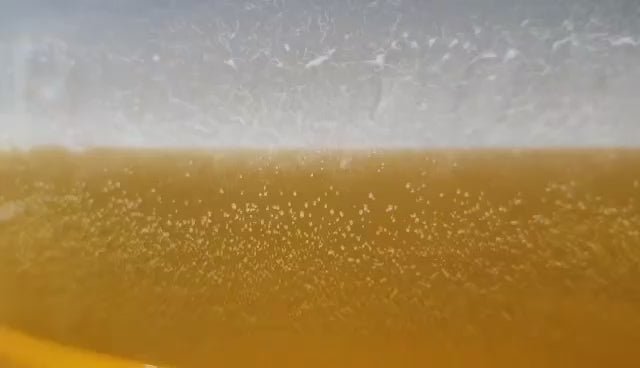
Picture this: you’re at a restaurant, enjoying a gourmet salad drizzled with tangy vinaigrette. Just like you savor your meal, vinegar eels have their way of tackling their food. They might seem simple, but their feeding mechanism is quite sophisticated when you really get into it. Let’s explore how these tiny organisms feast and survive, step by step.
Understanding Vinegar Eels
Vinegar eels (scientifically known as *Turbatrix aceti*) are part of the roundworm family found in—you guessed it—vinegar! They thrive in acidic conditions, primarily in unfiltered apple cider vinegar, where they feed on natural bacteria. This makes them an interesting part of the ecosystem in vinegar and shows how life can adapt to various environments.
These little guys are typically transparent and can grow to about 1-2 centimeters long. When you look closely, you may notice their elongated bodies and the way they swim, which resembles a gentle corkscrew motion. They have developed a unique ability to survive and reproduce in environments that would be inhospitable for many other organisms.
Understanding vinegar eels is the first step to appreciating how they function and how their feeding mechanism works. Let’s break down that feeding process next.
How Do Vinegar Eels Feed?
Vinegar eels are filter feeders, which means they extract food particles from their environment. Imagine them as tiny vacuum cleaners, constantly sucking up what they need to survive. Their main diet consists of microorganisms, organic matter, and bacteria found in the vinegar.
Here’s how it works: when they swim through the liquid, they use a structure called a “pharynx” to help them suck in their food. This pharynx acts like a straw, drawing in water along with any tiny particles suspended in it. You might be wondering, what exactly do they consume? Let’s break that down further.
What’s on the Menu?
Vinegar eels primarily feed on:
- Bacteria: These are their main food source. Vinegar contains natural cultures of bacteria, which thrive in acidic conditions.
- Yeast: Often present in vinegar, yeast provides essential nutrients.
- Cellular Debris: Any leftover organic matter in vinegar, like decomposing plant material, is also on the menu.
By feeding on these microorganisms, vinegar eels play a crucial role in breaking down organic matter and recycling nutrients. So, in a way, they help keep the vinegar ecosystem balanced!
The Feeding Mechanism Step-by-Step
Now that you have a general idea of what vinegar eels eat, let’s explore their feeding mechanism step-by-step. It’s fascinating to see how nature equips these tiny beings for survival.
Step 1: Locomotion
First, vinegar eels move through the liquid using a unique swimming motion. Their bodies undulate in a corkscrew fashion, allowing them to navigate the vinegar easily. This swimming style is efficient, helping them cover ground and locate food sources.
Step 2: Sensory Perception
As they swim, vinegar eels utilize sensory structures to detect food. They’re equipped with chemoreceptors that help them sense changes in their environment, like concentrations of bacteria. This enables them to hone in on the tastiest morsels. Can you imagine having the ability to “smell” food underwater? It’s pretty cool!
Step 3: Ingestion
Once they locate food, the eels use their pharynx to intake water and food particles. The pharynx opens up, and like that little straw analogy, they create suction to draw in both. This process happens quickly, allowing them to consume a substantial amount of food in a short time.
Step 4: Digestion
After ingestion, the food moves into their digestive tract. Here, enzymes break down the food into nutrients that their bodies can use. It’s interesting to note that vinegar eels have a simple digestion system, but it’s perfectly tuned to their needs.
Importance of Vinegar Eels in the Ecosystem
You might be asking, “Why should I care about these tiny eels?” Well, they play an essential role in the vinegar ecosystem! By feeding on bacteria and organic matter, vinegar eels help maintain a balanced microenvironment.
For instance, their feeding helps control bacterial populations, ensuring that vinegar doesn’t become overloaded with excessive bacterial growth. This is vital not just for the health of vinegar but for the overall ecosystem where they live. As they thrive, they contribute to nutrient cycling, making them an integral part of their habitat.
Are Vinegar Eels Beneficial to Humans?
You might be surprised to learn that vinegar eels aren’t just beneficial to their environment; they can also have advantages for humans. Many aquarium enthusiasts and fish keepers use vinegar eels as a live food source for young fish. Their small size and high nutritional content make them easy to digest, providing essential nutrients as fish grow.
Additionally, some studies suggest that the microorganisms present in vinegar, including those that vinegar eels feed on, can promote gut health in humans. It’s a fascinating connection between these little creatures and our own health!
Vinegar eels may be small, but their role in their ecosystem is mighty. Their unique feeding mechanism not only allows them to thrive in acidic environments but also helps maintain balance in the vinegar ecosystem—which ultimately benefits us too.
Whether you’re a curious observer or a fish keeper looking for a nutritious food source, understanding vinegar eels gives you a glimpse into the complexities of nature. So next time you see those tiny wrigglers in a jar, remember the incredible journey they embark on for their next meal!
